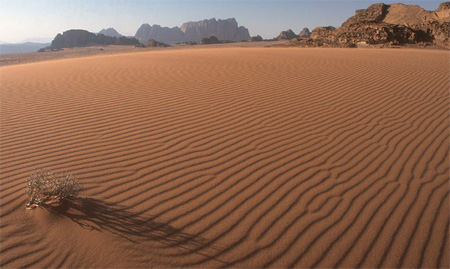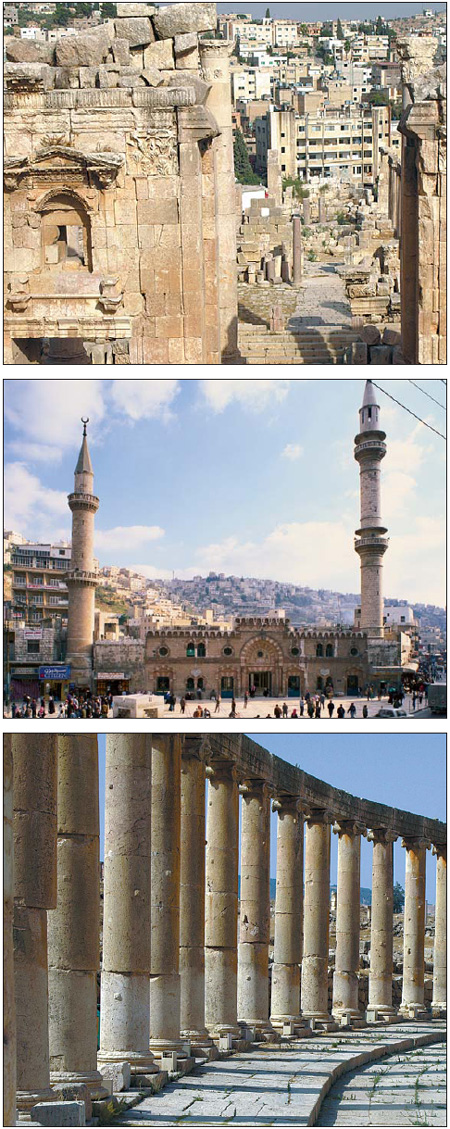Crossing Jordan
|
A safari into Wadi Rum is appealing for avid climbers and anyone looking for a break from reality. Provided to China Daily |
In the middle of much regional turbulence, one small kingdom is a travelers' oasis. Elizabeth Kerr discovers the attractions.
Summer in this Middle Eastern kingdom is a boon for travelers who really want to explore. Under the blazing midday sun, Muslim worshippers spill onto the streets around the Al-Husseini Mosque in the middle of old Amman. Right near the city's busiest market, the pavement outside one of the region's biggest mosques is crowded with the devout who have just finished afternoon prayer. Elsewhere, non-Muslims respectfully go about their business. To see the snarled traffic come to a standstill and a hush fall over the bustling city is mesmerizing. It is also a perfect snapshot of modern Jordan.
Those of us who don't live there are convinced that the Middle East is a radically devout region of the world where travel is fraught with danger.
In the middle of the fray is the Hashemite Kingdom of Jordan, a tiny country of 6.5 million - fewer people than live in Hong Kong or Harbin. There's no disputing the region has its problems, but Jordan is unusual. The country prides itself on its tolerance and progressiveness, and a profound ethnic and religious mix is evident.
It's also the ideal gateway to some fascinating destinations, including Damascus (a two-hour drive from the capital, Amman), Egypt and Israel. Jordan's history is a long one and there are traces of it in every corner of the country.
Like any other tourist destination, Jordan has its high season, and most vacationers opt to head over between October and April, when the weather is at its most comfortable. Though Jordan sits on the river of the same name and the Jordan Rift Valley boasts year-round agriculture, the Arabian Desert looms not far to the west.
Summers are extremely hot and dry, but tourist numbers are way down, making popular sites at Jerash, Petra and Wadi Rum infinitely easier to navigate.
Since King Abdullah II took power in 1999, Amman has become the go-to location for Middle Eastern business in banking, investment, and other services industries. Hyatt, Four Seasons, and Marriott are among the international hotel chains operating not far from the shiny office towers, and upmarket shopping blocks.
Capital attractions
Amman's history is in the old city, and a day or two should include the mosques, the Citadel, the Roman Theater, and the city's main market. For cooks, spices that run into three figures can be bargained down to a fraction of the price.
The old city is where you'll find swish bistros butting up against local haunts dishing up lamb-based mansaf and mezze. Small eateries have a variety of Jordanian food that extends beyond falafel, and you can grab a cup of coffee at a cafe or a roadside coffee stall.
Jordanians drink a lot of coffee and it's not for the faint of heart: It's thick, blacker than black, and pungent. If you have an early start the next day, don't drink it.
To see the rest of the country, get on the road. Renting a car is simple, roads are good and clearly signposted in English and Arabic. Jordanians are welcoming, so getting lost isn't an issue.
A drive from Amman to the southern port city of Aqaba can be as short as four hours on the Desert Highway - slightly more on the meandering King's Highway, which is kind of like the US Route 66. If you don't want the hassle of driving through checkpoints, personalized tour operators like Douna Tours (www.dounatours.com) can arrange an itinerary on almost any budget, and Douna staff is infinitely patient and helpful.
A plus when traveling in the slow summer season is the strong chance of getting a personal guide for a small group of two to four people. Just you, some friends and the desert.
Jerash sits just north of Amman, and will likely be your first stop. The city is home to Roman ruins that not even Rome can match, impeccably preserved and incredibly detailed. Tour guides at the site are recommended, and most are working archaeologists with encyclopedic knowledge of the ancient city. The bustle of the old empire is vivid, regardless of the fact that a shell is all that remains. Those shells are scattered across Jordan, but the one that everyone comes to see isn't Roman. It's the 6th century BC Nabataean city of Petra.
The ancient city known for its rock-cut architecture, defined by the Treasury (now viewable only from the outside thanks to discourteous tourists behaving badly), truly lives up to its reputation. Just for fun, ask your park guide what he really thinks of Indiana Jones and the Last Crusade shooting there.
It's difficult not to feel a sense of anticipation when coming through the Siq, the natural gorge that leads to the main attraction. Petra invites a lot of walking, and there's a great deal more to the park itself than that one building. Making it a day trip is do-able, but two is infinitely more comprehensive. Must-haves for summer are lots of water and strong thighs: the 800 steps to Ad Deir, the Monastery, can feel like 8,000. However the view from the top is something to behold.
Sand and water
No trip to Jordan would be complete without sleeping on its most famous sands and taking a dip in its most famous waters: Wadi Rum, the sandstone-ringed desert valley, the Dead Sea and the Red Sea feeder the Gulf of Aqaba.
A safari into Wadi Rum is nearly ideal for avid climbers and anyone looking for a break from reality. The granite walls that ring the valley are inviting but challenging and the rolling, track free dunes farther out are eerily peaceful. Organized camps dot the Wadi, but individualized treks farther out offer a spectacular slice of Bedouin life sleeping under desert stars. A camp dinner should include a shot of araq, a cloudy anise-based aperitif, zerb, a lamb and potato dish cooked slowly underground, followed by a hubbly-bubbly - what trendy bars in Asia call their overpriced hookahs.
The buoyant waters of the Dead Sea are as murky and caustic as the Gulf's are surrealistically blue. The Dead Sea can be accessed from any of the hotels that dot its shores (budget and five-star), and skipping it is like bypassing Paris when you're in France. But the modern resort town of Aqaba, Jordan's only seaport, is a bit of a revelation. Leaping into the crystalline water from an easily rented motorboat is the best way to experience the Gulf's waters and their amazing reefs. It's a refreshing tonic to the blistering summer heat as well as the popular picture of the Middle East.
You can contact the writer at sundayed@chinadaily.com.cn.
|
Jerash is home to Roman ruins that not even Rome can match, impeccably preserved and incredibly detailed (top and above). Muslim worshippers spill onto the streets around the Al-Husseini Mosque in the middle of old Amman (middle). |

(China Daily 08/07/2011 page16)




















